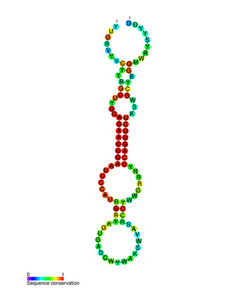Biology:miR-146
| miR-146 | |
|---|---|
 Conserved secondary structure of miR-146 microRNA precursor | |
| Identifiers | |
| Symbol | miR-146 |
| Alt. Symbols | MIR146 |
| Rfam | RF00691 |
| miRBase | MI0000477 |
| miRBase family | MIPF0000103 |
| NCBI Gene | 406938 |
| HGNC | 31533 |
| OMIM | 610566 |
| RefSeq | NR_029897 |
| Other data | |
| RNA type | miRNA |
| Domain(s) | Mammalia |
| GO | 0035195 |
| SO | 0001244 |
| Locus | Chr. 5 q34 |
| PDB structures | PDBe |
miR-146 is a family of microRNA precursors found in mammals, including humans. The ~22 nucleotide mature miRNA sequence is excised from the precursor hairpin by the enzyme Dicer.[1] This sequence then associates with RISC which effects RNA interference.[2]
miR-146 is primarily involved in the regulation of inflammation and other process that function in the innate immune system.[3] Loss of functional miR-146 (and mir-145) could predispose an individual to suffer from chromosome 5q deletion syndrome.[4] miR-146 has also been reported to be highly upregulated in osteoarthritis cartilage, and could be involved in its pathogenesis.[5] mir-146 expression is associated with survival in triple negative breast cancer.[6]
Function
miR-146 is thought to be a mediator of inflammation along with another microRNA, mir-155. The expression of miR-146 is upregulated by inflammatory factors such as interleukin 1 and tumor necrosis factor-alpha.[7] miR-146 dysregulates a number of targets which are mostly involved in toll-like receptor pathways that bring about a cytokine response as part of the innate immune system.[3][7] miR-146 operates in a feedback system or "negative regulatory loop"[8] to finely tune inflammatory responses.[4]
Applications
miR-146 could be used as a biomarker for sepsis.[9] In addition it was found to be absent from the exosomes of prion infected cells suggesting it could be used as a biomarker for prion infection.[10] miR-146a could be targeted therapeutically as its depletion has implication in the hyperactive response to infection.[11]
References
- ↑ "microRNAs: tiny regulators with great potential". Cell 107 (7): 823–6. Dec 2001. doi:10.1016/S0092-8674(01)00616-X. PMID 11779458.
- ↑ "Human RISC couples microRNA biogenesis and posttranscriptional gene silencing". Cell 123 (4): 631–40. Nov 2005. doi:10.1016/j.cell.2005.10.022. PMID 16271387.
- ↑ 3.0 3.1 "MicroRNAs and immunity: novel players in the regulation of normal immune function and inflammation". Seminars in Cancer Biology 18 (2): 131–40. Apr 2008. doi:10.1016/j.semcancer.2008.01.005. PMID 18291670.
- ↑ 4.0 4.1 "A trio of microRNAs that control Toll-like receptor signalling". International Immunology 23 (7): 421–5. Jul 2011. doi:10.1093/intimm/dxr034. PMID 21652514.
- ↑ "Expression of MicroRNA-146a in osteoarthritis cartilage". Arthritis and Rheumatism 60 (4): 1035–41. Apr 2009. doi:10.1002/art.24404. PMID 19333945.
- ↑ Lánczky, András; Nagy, Ádám; Bottai, Giulia; Munkácsy, Gyöngyi; Szabó, András; Santarpia, Libero; Győrffy, Balázs (2016-12-01). "miRpower: a web-tool to validate survival-associated miRNAs utilizing expression data from 2178 breast cancer patients". Breast Cancer Research and Treatment 160 (3): 439–446. doi:10.1007/s10549-016-4013-7. ISSN 1573-7217. PMID 27744485.
- ↑ 7.0 7.1 "Adding fuel to fire: microRNAs as a new class of mediators of inflammation". Annals of the Rheumatic Diseases 67 (Suppl 3): iii50-5. Dec 2008. doi:10.1136/ard.2008.100289. PMID 19022814.
- ↑ "MicroRNAs in NF-kappaB signaling". Journal of Molecular Cell Biology 3 (3): 159–66. Jun 2011. doi:10.1093/jmcb/mjr007. PMID 21502305.
- ↑ "[MicroRNA's role in sepsis and endotoxin tolerance. More players on the stage]". Chirurgia (Bucur.) 105 (5): 625–30. Sep–Oct 2010. PMID 21141085.
- ↑ "Small RNA deep sequencing reveals a distinct miRNA signature released in exosomes from prion-infected neuronal cells". Nucleic Acids Research 40 (21): 10937–49. Nov 2012. doi:10.1093/nar/gks832. PMID 22965126.
- ↑ "microRNA regulation of inflammatory responses". Annual Review of Immunology 30: 295–312. 2012. doi:10.1146/annurev-immunol-020711-075013. PMID 22224773.
Further reading
- "MicroRNAs in immune regulation--opportunities for cancer immunotherapy". The International Journal of Biochemistry & Cell Biology 42 (8): 1256–61. Aug 2010. doi:10.1016/j.biocel.2010.02.002. PMID 20144731.
- "New clues to the molecular pathogenesis of myelodysplastic syndromes". Experimental Cell Research 316 (8): 1390–6. May 2010. doi:10.1016/j.yexcr.2010.02.043. PMID 20211165.
- "MicroRNA-146a in autoimmunity and innate immune responses". Annals of the Rheumatic Diseases 72 (Suppl 2): ii90-5. Apr 2013. doi:10.1136/annrheumdis-2012-202203. PMID 23253933.
See also
- microRNA (miRNA)
External links
 |

